Ernst Röhm

Ernst Röhm

Ernst Röhm | |
|---|---|
| Stabschef of the Sturmabteilung | |
| In office 5 January 1931 – 1 July 1934 | |
| Leader | Adolf Hitler (as Oberste SA-Führer) |
| Preceded by | Otto Wagener |
| Succeeded by | Viktor Lutze |
| Personal details | |
| Born | Ernst Julius Günther Röhm (1887-11-28)28 November 1887 Munich, Bavaria, German Empire |
| Died | 1 July 1934(1934-07-01)(aged 46) Stadelheim Prison, Munich, Germany |
| Cause of death | Execution |
| Resting place | Westfriedhof, Munich |
| Nationality | German |
| Political party | National Socialist German Workers' Party (NSDAP) |
| Other political affiliations | German Workers' Party |
| Parents | Guido Julius Josef Röhm (father) Sofia Emilie (mother) |
| Signature |  |
| Military service | |
| Allegiance | |
| Branch/service | Royal Bavarian Army Reichswehr Bolivian Army Sturmabteilung |
| Years of service | 1906–1923 |
| Rank | Hauptmann Lieutenant colonel (Bolivia) Stabschef (Sturmabteilung) |
| Battles/wars | World War I |
| Awards | Iron Cross First Class |
Ernst Julius Günther Röhm (German: [ˈɛɐ̯nst ˈʁøːm]; 28 November 1887 – 1 July 1934) was a German military officer and an early member of the Nazi Party. As one of the members of its predecessor, the German Workers' Party, he was a close friend and early ally of Adolf Hitler and a co-founder of the Sturmabteilung (SA, "Storm Battalion"), the Nazi Party's militia, and later was its commander. By 1934, the German Army feared the SA's influence and Hitler had come to see Röhm as a potential rival, so he was executed during the Night of the Long Knives.
Ernst Röhm | |
|---|---|
| Stabschef of the Sturmabteilung | |
| In office 5 January 1931 – 1 July 1934 | |
| Leader | Adolf Hitler (as Oberste SA-Führer) |
| Preceded by | Otto Wagener |
| Succeeded by | Viktor Lutze |
| Personal details | |
| Born | Ernst Julius Günther Röhm (1887-11-28)28 November 1887 Munich, Bavaria, German Empire |
| Died | 1 July 1934(1934-07-01)(aged 46) Stadelheim Prison, Munich, Germany |
| Cause of death | Execution |
| Resting place | Westfriedhof, Munich |
| Nationality | German |
| Political party | National Socialist German Workers' Party (NSDAP) |
| Other political affiliations | German Workers' Party |
| Parents | Guido Julius Josef Röhm (father) Sofia Emilie (mother) |
| Signature |  |
| Military service | |
| Allegiance | |
| Branch/service | Royal Bavarian Army Reichswehr Bolivian Army Sturmabteilung |
| Years of service | 1906–1923 |
| Rank | Hauptmann Lieutenant colonel (Bolivia) Stabschef (Sturmabteilung) |
| Battles/wars | World War I |
| Awards | Iron Cross First Class |
Early career
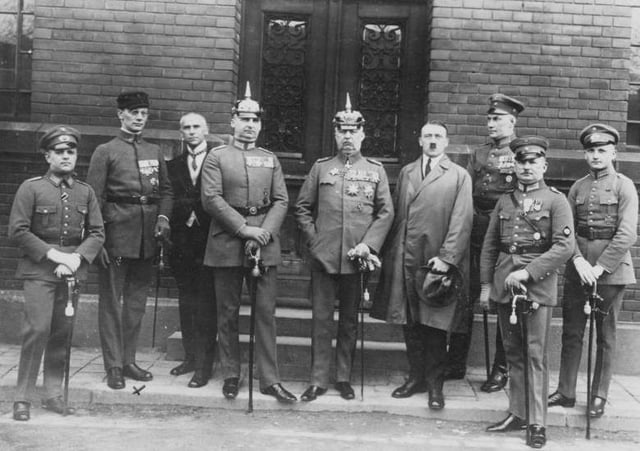
Defendants in the Beer Hall Putsch trial. From left to right: Pernet, Weber, Frick, Kriebel, Ludendorff, Hitler, Bruckner, Röhm, and Wagner.
Ernst Röhm was born in Munich, the youngest of three children—he had an elder sister and brother—of Emilie and Julius Röhm. His father Julius, a railway official, was described as strict, but once he realized that his son responded better without exhortation, allowed him significant freedom to pursue his interests.[6] Although the family had no military tradition, Röhm entered the Royal Bavarian 10th Infantry Regiment Prinz Ludwig at Ingolstadt as a cadet on 23 July 1906 and was commissioned on 12 March 1908.[7][8] At the outbreak of World War I in August 1914, he was adjutant of the 1st Battalion, 10th Infantry Regiment König. The following month, he was seriously wounded in the face at Chanot Wood in Lorraine and carried the scars for the rest of his life.[9] He was promoted to first lieutenant (Oberleutnant) in April 1915.[10] During an attack on the fortification at Thiaumont, Verdun, on 23 June 1916, he sustained a serious chest wound and spent the remainder of the war in France and Romania as a staff officer.[11] He was awarded the Iron Cross First Class before being wounded at Verdun, and was promoted to captain (Hauptmann) in April 1917.[12][13] Among his comrades, Röhm was considered a "fanatical, simple-minded swashbuckler" who frequently displayed contempt for danger.[14] In his memoirs, Röhm reported that during the autumn of 1918, he contracted the deadly Spanish influenza and was not expected to live, but that he recovered after a lengthy convalescence.[15]
Following the armistice on 11 November 1918 that ended the war, Röhm continued his military career as a captain in the Reichswehr.[14] He was one of the senior members in Colonel von Epp's Bayerisches Freikorps für den Grenzschutz Ost ("Bavarian Free Corps for Border Patrol East"), formed in Ohrdruf in April 1919, which finally overturned the Munich Soviet Republic by force of arms on 3 May 1919. In 1919 he joined the German Workers' Party (DAP), which the following year became the National Socialist German Workers Party (NSDAP).[16] Not long afterward he met Adolf Hitler, and they became political allies and close friends.[17] Röhm resigned or retired from the Reichswehr on 26 September 1923.[16] Throughout the early 1920s, Röhm remained an important intermediary between Germany's right-wing paramilitary organizations and the Reichswehr.[18] Additionally, it was Röhm who persuaded his former army commander, Colonel von Epp, to join the Nazis, an important development since Epp helped raise the sixty-thousand marks needed to purchase the Nazi periodical, the Völkischer Beobachter.[19]
When the Nazi Party held its "German Day" celebration at Nuremberg during early September 1923, it was Röhm who helped bring together some 100,000 participants drawn from right-wing militant groups, veteran's associations, and other paramilitary formations—which included the Bund Oberland, Reichskriegsflagge, the SA, and the Kampfbund—all of them subordinate to Hitler as "political leader" of the collective alliance.[20]
Röhm led the Reichskriegsflagge militia at the time of the Munich Beer Hall Putsch.[1] He rented the cavernous main hall of the Löwenbräukeller, supposedly for a reunion and festive comradeship. Meanwhile, Hitler and his entourage were at the Bürgerbräukeller.[22] It was here that Röhm planned to announce the revolution and use the units at his disposal to obtain weapons from secret caches with which to occupy crucial points in the centre of the city.[23] When the call came, he announced to those assembled in the Löwenbräukeller that the Kahr government had been deposed and Hitler had declared a "national revolution" which elicited wild cheering. Röhm then led his force of nearly 2,000 men to the War Ministry,[24] which they occupied for sixteen hours.[2] Once in control of the Reichswehr headquarters, Röhm awaited news, barricaded inside.[25] The subsequent march into the city center led by Hitler, Hermann Göring, and General Erich Ludendorff with banners flying high, was ostensibly undertaken to "free" Röhm and his forces.[26]
While crowds cheered—whipped into a frenzy by Strasser—shouting Heil, the armed ragtag assembly wearing red swastika armbands accompanying Hitler and company encountered blue-uniformed Bavarian State Police, who were prepared to counter the Putsch.[27] Around the time the marchers reached the Feldherrnhalle near the city center, shots rang out, scattering the participants. Before the exchange of gunfire ended, there were fourteen dead Nazis lying in the street and four policemen; the putsch had failed and the Nazis' first bid for power had lasted less than twenty-four hours.[28]
Following the failed Beer Hall Putsch of 9 November 1923, Röhm, Hitler, General Ludendorff, Lieutenant Colonel Hermann Kriebel and six others were tried in February 1924 for high treason. Röhm was found guilty and sentenced to fifteen months in prison, but the sentence was suspended and he was placed on probation.[16] Hitler was found guilty and sentenced to five years' imprisonment, but served only nine months at Landsberg Prison (under permissively lenient conditions), during which time he dictated most of the first volume of Mein Kampf ("My Struggle").[29][30]
In April 1924, Röhm became a Reichstag deputy for the völkisch (racial-national) National Socialist Freedom Party.[31] He made only one speech, urging the release of Lieutenant Colonel Kriebel. The seats won by his party were much reduced in the December 1924 election, and his name was too far down the list to return him to the Reichstag. While Hitler was in prison, Röhm helped to create the Frontbann as a legal alternative to the then-outlawed Sturmabteilung (SA). Hitler did not fully support the ambitious plans that Röhm had for this organization, which proved problematic. Hitler was distrustful of these paramilitary organizations because competing groups like the Bund Wiking, the Bund Bayern und Reich, and the Blücherbund were all vying for membership and he realized from the failed putsch that these groups could not be legitimized so long as the police and Reichwehr stayed loyal to the government.[31] When in April 1925 Hitler and Ludendorff disapproved of the proposals under which Röhm was prepared to integrate the 30,000-strong Frontbann into the SA, Röhm resigned from all political groups and military brigades on 1 May 1925. He felt great contempt for the "legalistic" path the party leaders wanted to follow and sought seclusion from public life.[16] In 1928, he accepted a post in Bolivia as adviser to the Bolivian Army, where he was given the rank of lieutenant colonel. In the autumn of 1930, Röhm received a telephone call from Hitler requesting his return to Germany.[16]
Sturmabteilung leader
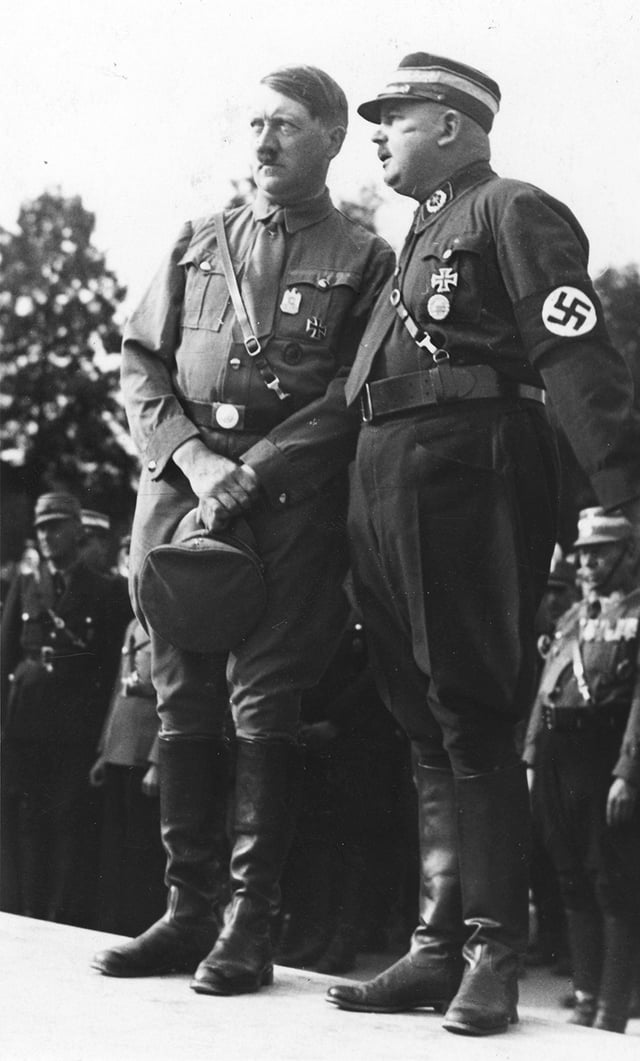
Röhm with Hitler, August 1933
In September 1930, as a consequence of the Stennes Revolt in Berlin, Hitler assumed supreme command of the SA as its new Oberster SA-Führer. He sent a personal request to Röhm, asking him to return to serve as the SA's Chief of Staff. Röhm accepted this offer and began his new assignment on 5 January 1931.[32] He brought radical new ideas to the SA, and appointed several close friends to its senior leadership. Previously, the SA formations were subordinate to the Nazi Party leadership of each Gau. Röhm established new Gruppe, which had no regional Nazi Party oversight. Each Gruppe extended over several regions and was commanded by a SA-Gruppenführer who answered only to Röhm or Hitler.[33]
The SA by this time numbered over a million members. Their initial assignment of protecting Nazi leaders at rallies and assemblies was taken over by the Schutzstaffel (SS) in relation to the top leaders.[34][35] The SA did continue its street battles against the communist, forces of rival political parties and violent actions against Jews and others deemed hostile to the Nazi agenda.[36]
Under Röhm, the SA often took the side of workers in strikes and other labor disputes, attacking strikebreakers and supporting picket lines. SA intimidation contributed to the rise of the Nazis and the violent suppression of right-wing parties during electoral campaigns, but its reputation for street violence and heavy drinking was a hindrance, as was the open homosexuality of Röhm and other SA leaders such as his deputy Edmund Heines.[37] In June 1931, the Münchener Post, a Social Democratic newspaper, began attacking Röhm and the SA regarding homosexuality in its ranks and then in March 1932, the paper obtained and published some private letters of his that left no doubt about his homosexuality; these letters were confiscated by the Berlin police back in 1931 and subsequently passed along to the journalist Helmuth Klotz.[38]
Hitler was aware of Röhm's homosexuality. Their friendship shows in that Röhm remained one of the few intimates allowed to use the familiar German du (the German familiar form of "you") when conversing with Hitler.[17] In turn, Röhm was the only Nazi leader who dared to address Hitler by his first name "Adolf" or his nickname "Adi" rather than "mein Führer".[39] Their close association led to rumors that Hitler himself was homosexual.[40] Unlike many in the Nazi hierarchy, Röhm never fell victim to Hitler's "arresting personality" nor did he come fully under his spell, which made him unique.[41]
As Hitler rose to national power with his appointment as chancellor in January 1933, SA members were appointed auxiliary police and ordered by Göring to sweep aside "all enemies of the state".[33]
Second revolution
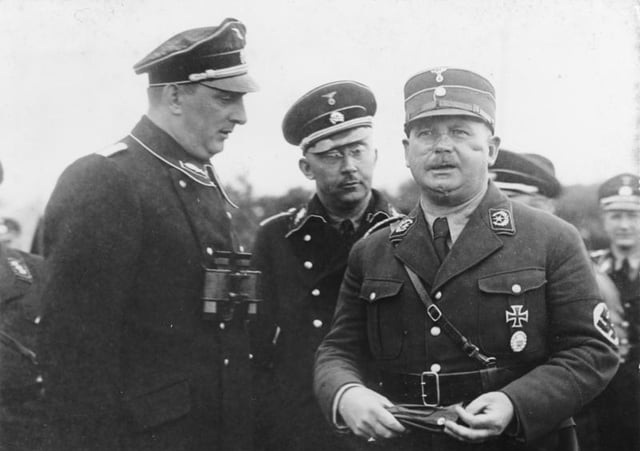
With Orpo Chief Kurt Daluege and SS Chief Heinrich Himmler, in August 1933
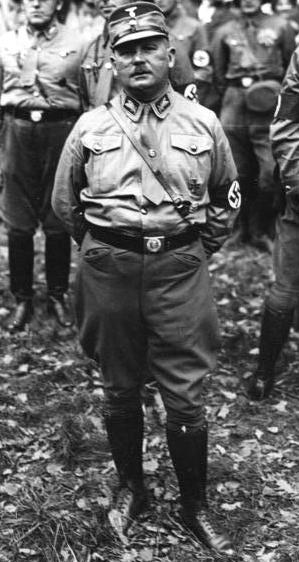
SA leader Ernst Röhm in Bavaria in 1934
Röhm and the SA regarded themselves as the vanguard of the "National Socialist revolution". After Hitler's national takeover they expected radical changes in Germany, including power and rewards for themselves, unaware that, as Chancellor, Hitler no longer needed their street-fighting capabilities.[42] Nevertheless, Hitler did name Röhm to the cabinet as a minister without portfolio.[43]
Along with other members of the more radical faction within the Nazi Party, Röhm advocated a "second revolution" that was overtly anti-capitalist in its general disposition.[44] These radicals rejected exploitative capitalism and they intended to take steps to curb monopolies and promoted the nationalization of land and industry.[44] Such plans were threatening to the business community in general, and to Hitler's corporate financial backers in particular—including many German industrial leaders he would rely upon for arms production—so to keep from alienating them Hitler swiftly reassured his powerful industrial allies that there would be no such revolution as espoused by these Party radicals.[45]
Many SA "storm troopers" had working-class origins and longed for a radical transformation of German society.[46] They were disappointed by the new regime's lack of socialistic direction and its failure to provide the lavish patronage they had expected.[47] Furthermore, Röhm and his SA colleagues thought of their force as the core of the future German Army, and saw themselves as replacing the Reichswehr and its established professional officer corps.[48] By then, the SA had swollen to over three million men, dwarfing the Reichswehr, which was limited to 100,000 men by the Treaty of Versailles. Although Röhm had been a member of the officer corps, he viewed them as "old fogies" who lacked "revolutionary spirit". He believed that the Reichswehr should be merged into the SA to form a true "people's army" under his command, a pronouncement that caused significant consternation within the army's hierarchy and convinced them that the SA was a serious threat.[49] At a February 1934 cabinet meeting, Röhm then demanded that the merge be made, under his leadership as Minister of Defence.[50]
This horrified the army, with its traditions going back to Frederick the Great. The army officer corps viewed the SA as an "undisciplined mob" of "brawling" street thugs, and was also concerned by the pervasiveness of "corrupt morals" within the ranks of the SA. Reports of a huge cache of weapons in the hands of SA members caused additional concern to the army leadership.[50] Unsurprisingly, the officer corps opposed Röhm's proposal. They insisted that discipline and honor would vanish if the SA gained control, but Röhm and the SA would settle for nothing less. In addition the army leadership was eager to co-operate with Hitler given his plan of re-armament and expansion of the established professional military forces.[48]
In February 1934, Hitler told British diplomat Anthony Eden of his plan to reduce the SA by two-thirds. That same month, Hitler announced that the SA would be left with only a few minor military functions. Röhm responded with complaints, and began expanding the armed elements of the SA. Speculation that the SA was planning a coup against Hitler became widespread in Berlin. In March, Röhm offered a compromise in which "only" a few thousand SA leaders would be taken into the army, but the army promptly rejected that idea.[51]
On 11 April 1934, Hitler met with German military leaders on the ship Deutschland. By that time, he knew President Paul von Hindenburg would likely die before the end of the year. Hitler informed the army hierarchy of Hindenburg's declining health and proposed that the Reichswehr support him as Hindenburg's successor. In exchange, he offered to reduce the SA, suppress Röhm's ambitions, and guarantee the Reichswehr would be Germany's only military force. According to war correspondent William L. Shirer, Hitler also promised to expand the army and navy.[52]
Although determined to curb the power of the SA, Hitler put off doing away with his long-time ally. A political struggle within the party grew, with those closest to Hitler, including Prussian premier Hermann Göring, Propaganda Minister Joseph Goebbels, and Reichsführer-SS Heinrich Himmler, positioning themselves against Röhm. To isolate the latter, on 20 April 1934, Göring transferred control of the Prussian political police (Gestapo) to Himmler, who he believed could be counted on to move against Röhm.[53]
Both the Reichswehr and the conservative business community continued to complain to Hindenburg about the SA. In early June, defence minister Werner von Blomberg issued an ultimatum to Hitler from Hindenburg: unless Hitler took immediate steps to end the growing tension in Germany, Hindenburg would declare martial law and turn over control of the country to the army.[54] The threat of a declaration of martial law from Hindenburg, the only person in Germany with the authority to potentially depose the Nazi regime, put Hitler under pressure to act. Hitler decided the time had come both to destroy Röhm and to settle scores with old enemies. Both Himmler and Göring welcomed Hitler's decision, since both had much to gain by Röhm's downfall—the independence of the SS for Himmler, and the removal of a rival for Göring.[55]
Death
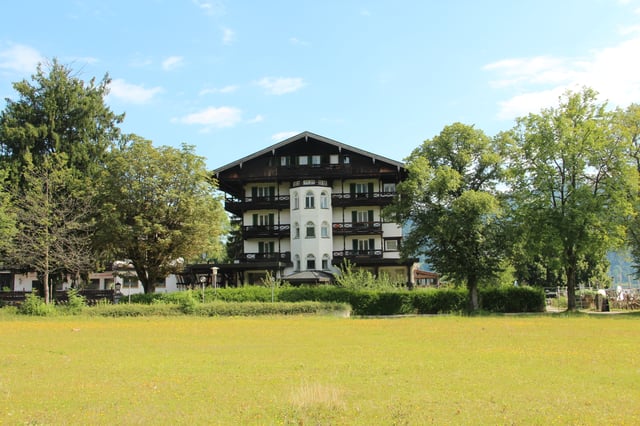
Hotel Lederer am See (former Hanselbauer Hotel) in Bad Wiessee before its planned demolition in 2017
In preparation for the purge known as the Night of the Long Knives, both Himmler and Reinhard Heydrich, chief of the SS Security Service, assembled a dossier of manufactured evidence to suggest that Röhm had been paid 12 million Reichsmarks (equivalent to € 48 million 2009) by the government of France to overthrow Hitler. Leading officers in the SS were shown falsified evidence on 24 June that Röhm planned to use the SA to launch a plot against the government (Röhm-Putsch).[56] At Hitler's direction, Göring, Himmler, Heydrich, and Victor Lutze drew up lists of people in and outside the SA to be killed. One of the men Göring recruited to assist him was Willi Lehmann, a Gestapo official and NKVD spy. On 25 June, General Werner von Fritsch placed the Reichswehr on the highest level of alert.[57] On 27 June, Hitler moved to secure the army's cooperation.[58] Blomberg and General Walther von Reichenau, the army's liaison to the party, gave it to him by expelling Röhm from the German Officers' League.[59] On 28 June, Hitler went to Essen to attend a wedding celebration and reception; from there he called Röhm's adjutant at Bad Wiessee and ordered SA leaders to meet with him on 30 June at 11:00 a.m.[55] On 29 June, a signed article in Völkischer Beobachter by Blomberg appeared in which Blomberg stated with great fervour that the Reichswehr stood behind Hitler.[60]
On 30 June 1934, Hitler and a large group of SS and regular police flew to Munich and arrived between 06:00 and 07:00 at Hanselbauer Hotel in Bad Wiessee, where Röhm and his followers were staying.[61] With Hitler's early arrival, the SA leadership, still in bed, were taken by surprise. SS men stormed the hotel and Hitler personally placed Röhm and other high-ranking SA leaders under arrest. According to Erich Kempka, Hitler turned Röhm over to "two detectives holding pistols with the safety catch removed". The SS found Breslau SA leader Edmund Heines in bed with an unidentified eighteen-year-old male SA senior troop leader.[62] Goebbels emphasised this aspect in subsequent propaganda, justifying the purge as a crackdown on moral turpitude.[63] Kempka said in a 1946 interview that Hitler ordered both Heines and his partner taken outside of the hotel and shot.[64] Meanwhile, the SS arrested the other SA leaders as they left their train for the planned meeting with Röhm and Hitler.[65]
Although Hitler presented no evidence of a plot by Röhm to overthrow the regime, he nevertheless denounced the leadership of the SA.[63] Arriving back at party headquarters in Munich, Hitler addressed the assembled crowd. Consumed with rage, Hitler denounced "the worst treachery in world history". Hitler told the crowd that "undisciplined and disobedient characters and asocial or diseased elements" would be annihilated. The crowd, which included party members and many SA members fortunate enough to escape arrest, shouted its approval.[65] Joseph Goebbels, who had been with Hitler at Bad Wiessee, set the final phase of the plan in motion. Upon returning to Berlin, Goebbels telephoned Göring at 10:00 with the codeword kolibri ("hummingbird") to let loose the execution squads on the rest of their unsuspecting victims.[63] Leibstandarte SS Adolf Hitler commander Sepp Dietrich received orders from Hitler to form an "execution squad" and go to Stadelheim prison in Munich where Röhm and other SA leaders were being held under arrest.[66] There in the prison courtyard, the Leibstandarte firing squad shot five SA generals and an SA colonel.[67] Several of those not immediately executed were taken back to the Leibstandarte barracks at Lichterfelde, given one-minute "trials", and shot by a firing squad. Röhm himself, however, was kept prisoner.[68]
Hitler was hesitant in authorising Röhm's execution, perhaps because of loyalty or embarrassment about the execution of an important lieutenant; he eventually did so, and agreed that Röhm should have the option of suicide.[64] On 1 July, SS-Brigadeführer Theodor Eicke (later Kommandant of the Dachau concentration camp) and SS-Obersturmbannführer Michael Lippert visited Röhm. Once inside Röhm's cell, they handed him a Browning pistol loaded with a single bullet and told him he had ten minutes to kill himself or they would do it for him. Röhm demurred, telling them, "If I am to be killed, let Adolf do it himself."[64] Having heard nothing in the allotted time, Eicke and Lippert returned to Röhm's cell at 14:50 to find him standing, with his bare chest puffed out in a gesture of defiance.[69] Eicke and Lippert then shot Röhm, killing him.[70][3] SA-Obergruppenführer Viktor Lutze, who had been spying on Röhm, was named as the new Stabschef SA.[72]
While some Germans were shocked by the killings of 30 June to 2 July 1934, many others saw Hitler as the one who restored "order" to the country. Goebbels's propaganda highlighted the "Röhm-Putsch" in the days that followed. The homosexuality of Röhm and other SA leaders was made public to add "shock value", even though the sexuality of Röhm and other named SA leaders had been known by Hitler and other Nazi leaders for years.[73]
The purge of the SA was legalised on 3 July with a one-paragraph decree: the Law Regarding Measures of State Self-Defence, a step that historian Robin Cross contends was done by Hitler to cover his own tracks.[74] The Law declared, "The measures taken on 30 June, 1 and 2 July to suppress treasonous assaults are legal as acts of self-defence by the State." At the time no public reference was made to the alleged SA rebellion, but only generalised references to misconduct, perversion and some sort of plot.[75] In a nationally broadcast speech to the Reichstag on 13 July, Hitler justified the purge as a defence against treason.[76][77] Before the events of the Night of the Long Knives concluded, not only was Röhm dead, but more than 200 additional people had been killed,[4] including Nazi official Gregor Strasser, former chancellor General Kurt von Schleicher, and Franz von Papen's secretary, Edgar Jung.[78] Most of those murdered had little to no affiliation with Röhm but were killed for political reasons.[79]
Decorations and awards
See also
Persecution of homosexuals in Nazi Germany and the Holocaust
Glossary of Nazi Germany
History of Germany
List of Nazi Party leaders and officials